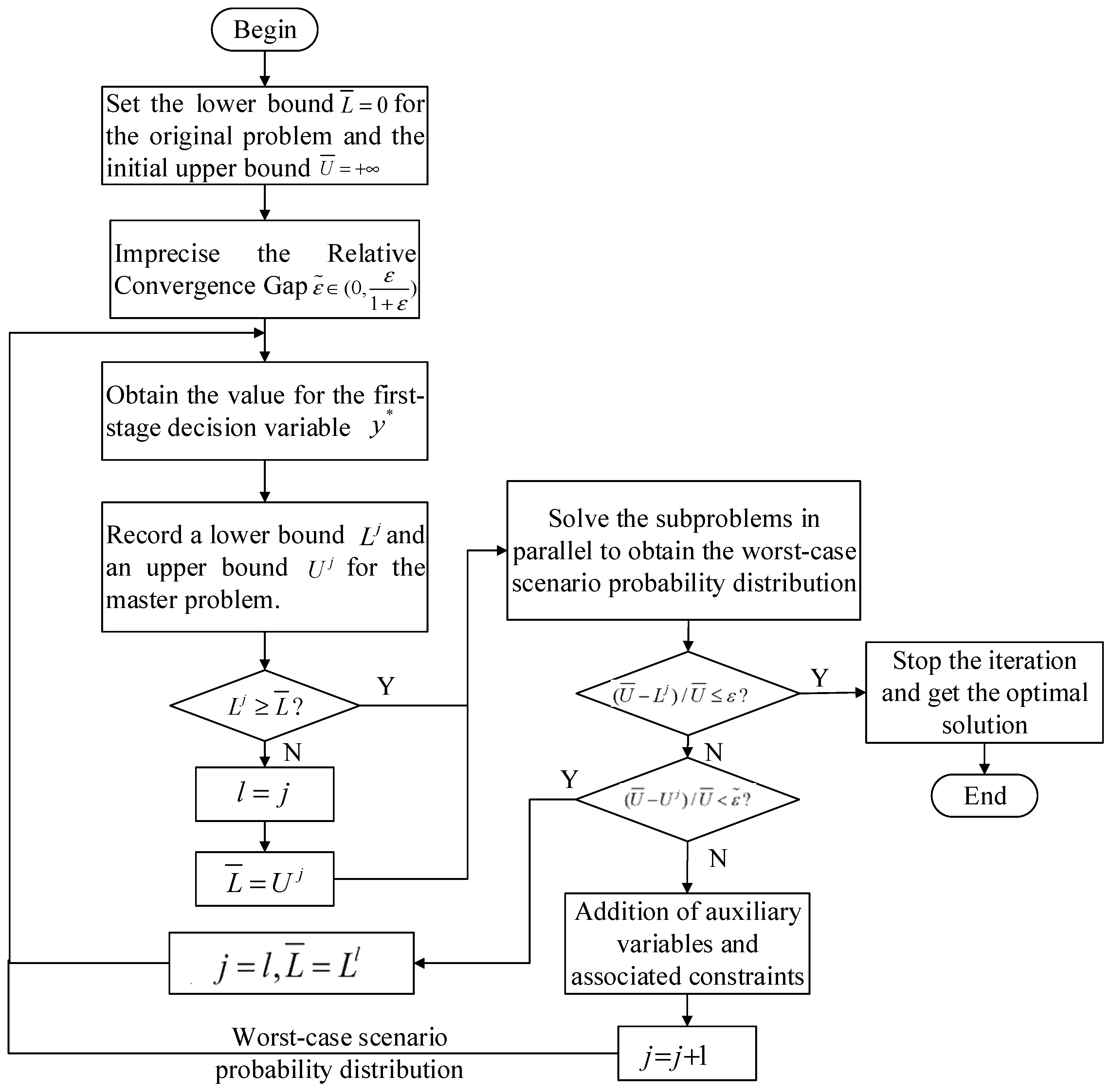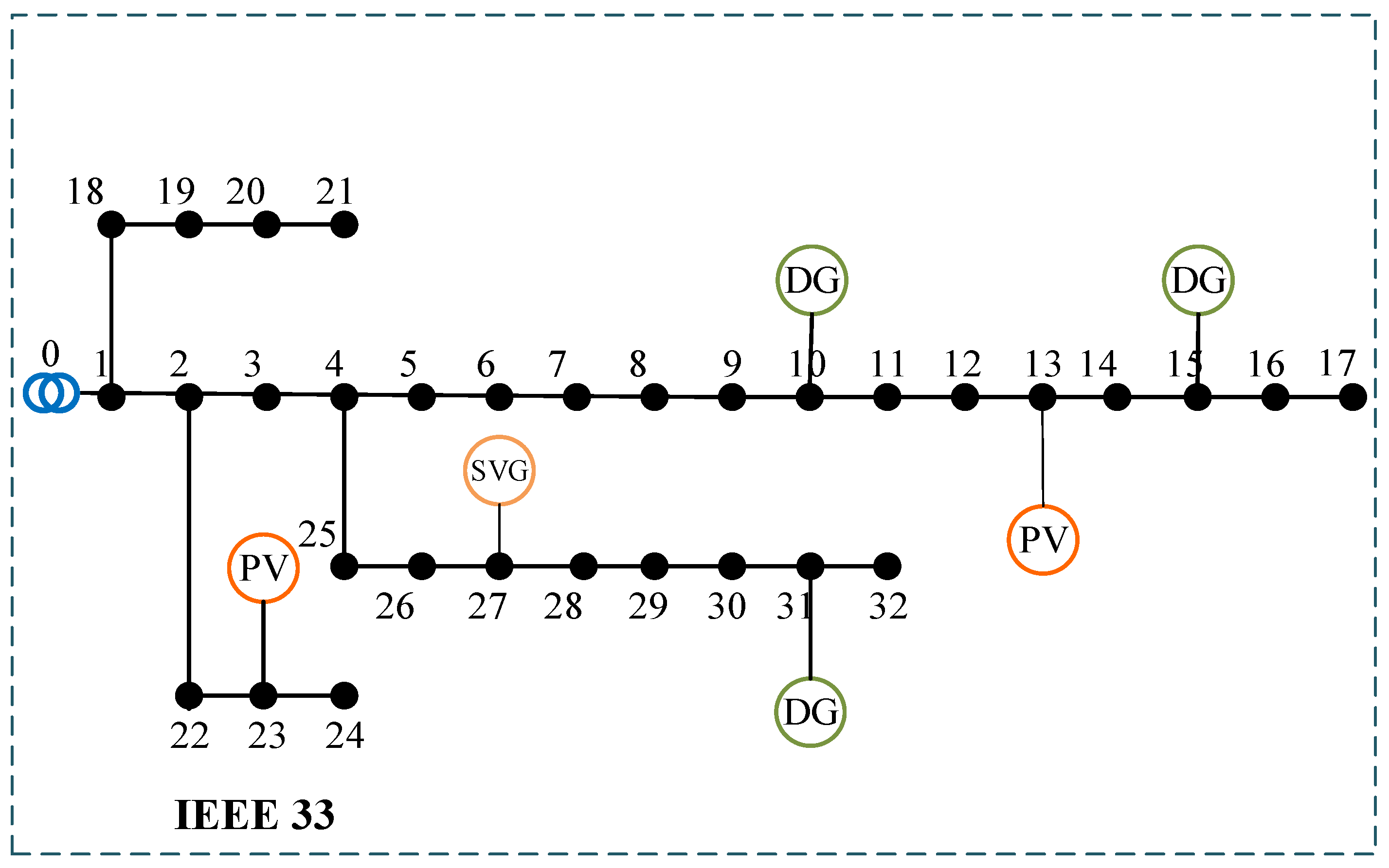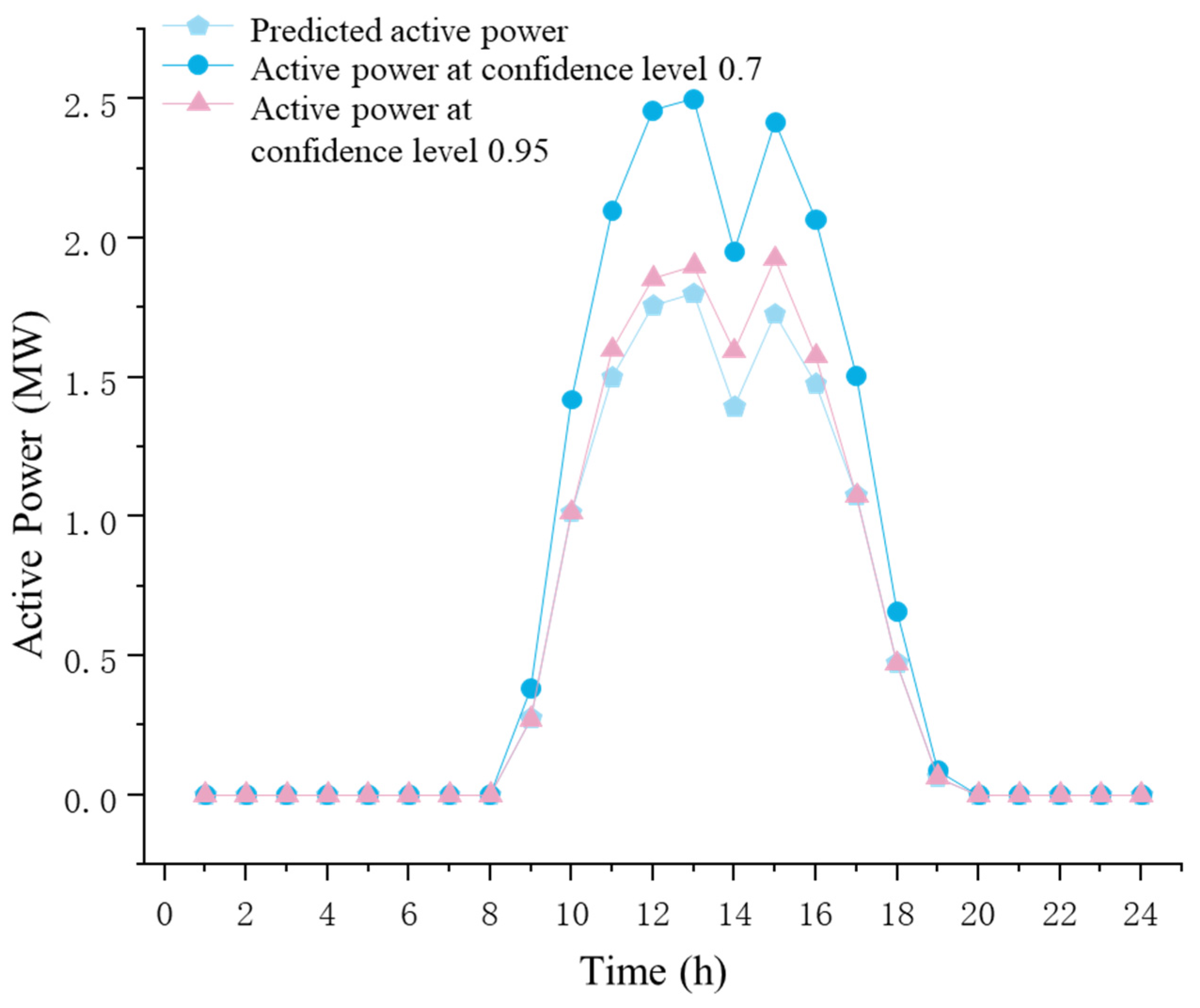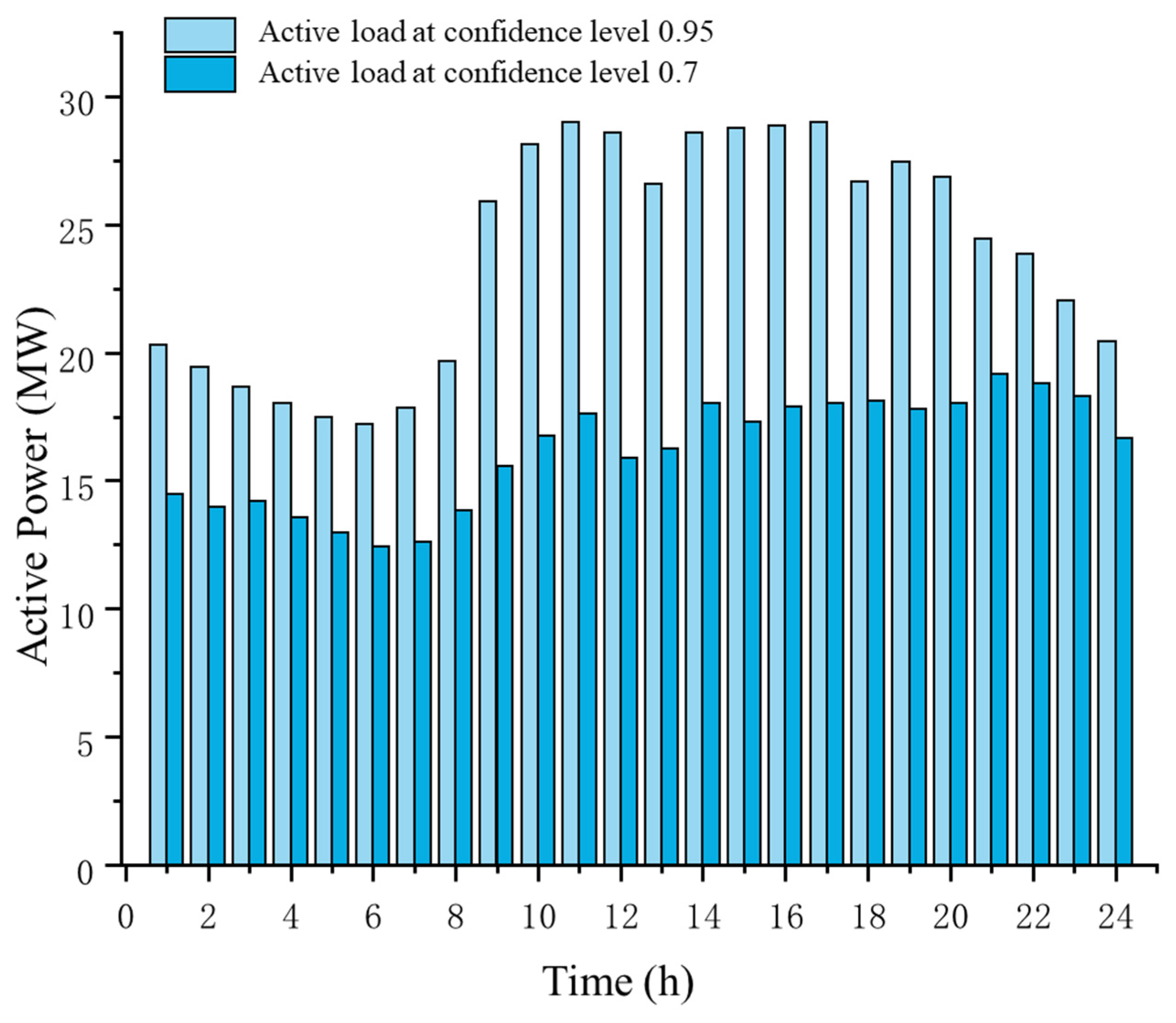Robust Optimization of Active Distribution Networks Considering Source-Side Uncertainty and Load-Side Demand Response
Abstract
1. Introduction
- (1)
- Most studies like Ref. [21] treat source PV volatility and load-side DR as independent uncertainties, ignoring their spatiotemporal correlations. This leads to over-conservative scheduling when coordinating DG dispatch and transferable loads.
- (2)
- Methods relying on Wasserstein/Kullback–Leibler divergence require accurate historical distributions, failing when source–load coupling causes distributional shifts.
- (3)
- Distributed algorithms like ADMM-based tripartite planning improve scalability but lack convergence guarantees under non-convex DR constraints [22].
- (1)
- Joint ambiguity set: A Wasserstein ball-constrained uncertainty set capturing source–load interactions via probability deviations.
- (2)
- Two-stage co-optimization: Integrating day-ahead power purchase (Stage 1) and real-time DG/PV/DR coordination (Stage 2).
- (3)
- iCCG acceleration: A dynamic gap-adjustment strategy reducing iterations by 35.2% versus standard CCG, resolving convergence issues in non-convex systems.
- (1)
- Uncertainty modeling dilemma: Source–load bilateral uncertainty is affected by weather, user behavior, and other factors; existing methods such as a single probability distribution assumptions cannot accurately portray its spatial and temporal correlation characteristics, resulting in significant deviation between the prediction model and the actual situation.
- (2)
- Multi-objective optimization contradiction: When dealing with different operating scenarios such as PV output fluctuation and demand response variations, the existing algorithms struggle to simultaneously satisfy the balance between the completeness of multi-scenario coverage and computational efficiency, as well as the synergy between robustness and economic optimization, often falling into the “over-conservative solution”. The existing algorithms often fall into the decision making dilemma of an “over-conservative solution” or “fragile optimal solution”.
2. Robust Optimization Model for Active Distribution Grid Distribution Considering Photovoltaic Uncertainty and Demand Response
2.1. Objective Function
2.2. Constraints
- (1)
- Current constraints for Distflow-based power flow modeling:
- (2)
- Distribution network node voltage constraints:
- (3)
- SVG reactive power output constraints:
- (4)
- Distribution network line current constraints:
- (5)
- Upper and lower constraints on active and reactive power output of PV generation:
- (6)
- DG active and reactive output upper and lower constraints:
- (7)
- Demand response load constraints
- (8)
- Distributed PV Output Uncertainty Set
3. Model Transformation Considering New Energy Output Uncertainty
3.1. Linearization of Uncertainty Fuzzy Sets
3.2. Linearization of Absolute Value Terms in Objective Functions
4. Algorithms for Solving Two-Stage Distributional Robust Optimization Models
5. Case Analysis
5.1. Parameterization
5.2. Simulation Results and Analysis
6. Conclusions
- Establishment of multi-objective synergistic optimization model: The established two-stage model effectively balances economic efficiency and robustness through a hierarchical optimization structure. The first stage minimizes deterministic power purchase costs, while the second stage addresses worst-case scenario losses and compensation costs. Case studies demonstrate a 5.7% reduction in operating costs compared to traditional robust optimization methods, along with a 30% decrease in load shedding capacity at a 0.95 confidence level. This dual-layer structure successfully resolves the dilemma between solution conservatism and economic optimality.
- Propose enhanced solver algorithms: The proposed iCCG algorithm improves computational efficiency by 35.2% compared to conventional CCG methods through a dynamic adjustment of convergence gaps and inexact constraint generation. The dynamic precision control mechanism reduces redundant iterations while maintaining solution accuracy, achieving an optimal balance between computational speed and optimization quality. This advancement effectively overcomes the dimensional curse issue in multi-scenario optimization problems.
- Establishment of an uncertainty management framework: The methodology combines probabilistic distribution ambiguity sets with linearization techniques, enabling comprehensive uncertainty modeling while ensuring computational tractability. The hybrid approach provides robust performance guarantees against prediction errors without excessive conservatism.
Author Contributions
Funding
Data Availability Statement
Conflicts of Interest
Abbreviations
| Abbreviations | Descriptions |
| PV | Photovoltaic |
| CCG | Column-and-Constraint Generation |
| iCCG | Inexact Column-and-Constraint Generation |
| ADN | Active Distribution Network |
| DRO | Distributional Robust Optimization |
| DR | Demand Response |
| DG | Distributed Generation |
| SVC | Static Var Compensator |
| SVG | Static Var Generator |
| ADMM | Alternating Direction Method of Multipliers |
| MP | Master Problem |
| SP | Subproblem |
| Notations | Descriptions |
| Cop | The power purchase cost of the distribution network |
| ps | The probability distribution of distributed PV power |
| Ep | Mathematical expectation |
| Ploss | The active loss of the distribution network |
| CDG | The operating cost of the DG in the distribution network |
| CPV | The penalty cost of solar curtailment under the worst probability distribution of PV power output |
| CDR | The compensation cost of the transferable loads |
| Cgd | The cost coefficient of power purchase |
| The purchased power of the distribution network at time t | |
| Iij,t | The current of branch i, j at time t of the distribution network |
| rij | The resistance of branch i, j |
| NDN | The set of branches of the distribution network |
| cdg | The cost coefficient of power generation of DG |
| The active output of DG at node j at time t | |
| NDG | The set of nodes where DG is located in the distribution network |
| cpv | The cost of penalty for abandoning the PV power generation coefficient |
| The maximum available active output of PV power at node j | |
| The planned active output of PV power at the node | |
| NPV | The set of nodes where PV power is located in the distribution grid |
| cdr | The compensation cost coefficient of the transferable load |
| The minimum power of the transferable load at node j after demand response | |
| The power of the transferable load at node j after demand response | |
| The maximum power of the transferable load at node j after demand response | |
| The power of the active load at node j prior to the demand response | |
| T | The set of time periods |
| The 0–1 variable of the movable load operating state at a specific time | |
| The minimum continuous working time of a movable load | |
| Pij,t | The active power of branch i,j |
| The set of first nodes in the distribution network with node i as the last node | |
| Pi,t | The net injected active power at node i |
| Pik,t | The active power of branch ik |
| Qij,t | The reactive power of branch i,j |
| xij | The reactance of the distribution network branch i,j |
| Qi,t | The net injected reactive power at node i |
| Qik,t | The reactive power of branch ik |
| The reactive power of DG at node i | |
| The reactive power of PV at node i | |
| The reactive power of SVC at node i | |
| The reactive power load of node i | |
| Lower limits of the node voltage magnitude | |
| Vi,t | The voltage magnitude at the first node i of the branch i,j |
| Vj,t | The voltage magnitude at the end node j of the branch i,j |
| Upper limits of the node voltage magnitude | |
| The lower limits of SVG reactive power output | |
| The reactive power of SVG at node i | |
| The upper limits of SVG reactive power output | |
| The maximum value of the line current squared | |
| The maximum power factor angle of the PV | |
| The lower limits of DG active output at node j | |
| The upper limits of DG active output at node j | |
| The lower limits of DG reactive output at node j | |
| The upper limits of DG reactive output at node j | |
| Ns | The total number of typical scenes obtained from historical data after scene aggregation |
| Ms | The number of typical scenes obtained from data after scene aggregation |
| The maximum deviation distance allowed between the actual probability and the initial probability distribution under the one-parameter constraint | |
| The maximum deviation distance allowed between the actual probability and the initial probability distribution under the ∞-paradigm constraint | |
| The initial probability of all typical scenarios |
Appendix A
References
- Manuel, A.; David, R.; Camilo, A. A Distributed Coordination Approach for Enhancing Protection System Adaptability in Active Distribution Networks. Energies 2024, 17, 4338. [Google Scholar] [CrossRef]
- Pan, P.; Chen, G.; Shi, H.; Zha, X.; Huang, Z. Distributed Robust Optimization Method for Active Distribution Network with Variable-Speed Pumped Storage. Electronics 2024, 13, 3317. [Google Scholar] [CrossRef]
- Ding, T.; Liu, S.; Yuan, W.; Bie, Z.; Zeng, B. A Two-Stage Robust Reactive Power Optimization Considering Uncertain Wind Power Integration in Active Distribution Networks. IEEE Trans. Sustain. Energy 2016, 7, 301–311. [Google Scholar] [CrossRef]
- Zhang, Y.; Zhang, J.; Wu, G.; Zheng, J.; Liu, D.; An, Y. Optimal Power Dispatch of Active Distribution Network and P2P Energy Trading Based on Soft Actor-critic Algorithm Incorporating Distributed Trading Control. J. Mod. Power Syst. Clean Energy 2025, 13, 540–551. [Google Scholar] [CrossRef]
- Park, B.; Chen, Y.; Olama, M.; Kuruganti, T.; Dong, J.; Wang, X.; Li, F. Optimal Demand Response Incorporating Distribution LMP with PV Generation Uncertainty. IEEE Trans. Power Syst. 2022, 37, 982–995. [Google Scholar] [CrossRef]
- Nikoobakht, A.; Zeraati, S.; Honkapuro, S.; Afrasiabi, M.; Aghaei, J. Toward Robust Decentralized Linear AC Operation of Cooperative Transmission and Distribution Networks. IEEE Access 2022, 10, 72603–72614. [Google Scholar] [CrossRef]
- Rayati, M.; Bozorg, M.; Cherkaoui, R.; Carpita, M. Distributionally Robust Chance Constrained Optimization for Providing Flexibility in an Active Distribution Network. IEEE Trans. Smart Grid 2022, 13, 2920–2934. [Google Scholar] [CrossRef]
- Zongxiang, L.U.; Yisha, L.I.N.; Ying, Q.I.A.O. Flexibility supply demand balance in power system with ultra-high proportion of renewable energy. Autom. Electr. Power Syst. 2022, 46, 3–16. [Google Scholar]
- Tao, A.; Zhou, N.; Chi, Y.; Wang, Q.; Dong, G. Multi-stage Coordinated Robust Optimization for Soft Open Point Allocation in Active Distribution Networks with PV. J. Mod. Power Syst. Clean Energy 2023, 11, 1553–1563. [Google Scholar] [CrossRef]
- Kalantar-Neyestanaki, M.; Sossan, F.; Bozorg, M.; Cherkaoui, R. Characterizing the Reserve Provision Capability Area of Active Distribution Networks: A Linear Robust Optimization Method. IEEE Trans. Smart Grid 2020, 11, 2464–2475. [Google Scholar] [CrossRef]
- Cui, Z.; Bai, X.; Li, P.; Li, B.; Cheng, J.; Su, X.; Zheng, Y. Optimal strategies for distribution network reconfiguration considering uncertain wind power. CSEE J. Power Energy Syst. 2020, 6, 662–671. [Google Scholar]
- Sepúlveda, J.; Angulo, A.; Mancilla-David, F.; Street, A. Robust Co-Optimization of Droop and Affine Policy Parameters in Active Distribution Systems with High Penetration of Photovoltaic Generation. IEEE Trans. Smart Grid 2022, 13, 4355–4366. [Google Scholar] [CrossRef]
- Hu, W.; Wang, P.; Gooi, H. Toward Optimal Energy Management of Microgrids via Robust Two-Stage Optimization. IEEE Trans. Smart Grid 2018, 9, 1161–1174. [Google Scholar] [CrossRef]
- Barhagh, S.S.; Mohammadi-Ivatloo, B.; Abapour, M.; Shafie-Khah, M. Optimal Sizing and Siting of Electric Vehicle Charging Stations in Distribution Networks With Robust Optimizing Model. IEEE Trans. Intell. Transp. Syst. 2024, 25, 4314–4325. [Google Scholar] [CrossRef]
- Luo, J.; Zhang, W.; Wang, H.; Wei, W.; He, J. Research on Data-Driven Optimal Scheduling of Power System. Energies. 2023, 16, 2926. [Google Scholar] [CrossRef]
- Park, J.Y.; Ban, J.; Kim, Y.J.; Catalão, J.P. Supplementary Feedforward Voltage Control in a Reconfigurable Distribution Network using Robust Optimization. IEEE Trans. Power Syst. 2022, 37, 4385–4399. [Google Scholar] [CrossRef]
- Chen, Y.; Wei, W.; Liu, F.; Mei, S. Distributionally robust hydro-thermal-wind economic dispatch. Appl. Energy 2016, 173, 511–519. [Google Scholar] [CrossRef]
- Wang, J.; Bian, Y.; Xu, Q.; Kong, X. Distributional robust optimal dispatching of microgrid considering risk and carbon trading mechanism. High Volt. Eng. 2023, 49, 1–12. [Google Scholar]
- Zhang, J.; Cui, M.; He, Y.; Li, F. Multi-period Two-stage Robust Optimization of Radial Distribution System with Cables Considering Time-of-use Price. J. Mod. Power Syst. Clean Energy 2023, 11, 312–323. [Google Scholar] [CrossRef]
- Zhang, K.; Wang, X.; Yang, H.; Jiang, C. Distributionally Robust Optimal Scheduling Method for Power System Under Flexibility Boundaries of Data Center Clusters. Automation of Electric Power Systems. 2024, 7, 235–247. [Google Scholar]
- Xuan, A.; Sun, Y.; Liu, Z.; Zheng, P.; Peng, W. An ADMM-based tripartite distributed planning approach in integrated electricity and natural gas system. Appl. Energy 2025, 338, 125660. [Google Scholar] [CrossRef]
- Lv, Q.; Wang, L.; Li, Z.; Song, W.; Bu, F.; Wang, L. Robust optimization for integrated production and energy scheduling in low-carbon factories with captive power plants under decision-dependent uncertainty. Appl. Energy 2025, 379, 124827. [Google Scholar] [CrossRef]
- Peyman, M.; Daniel, K. Data-driven distributionally robust optimization using the Wasserstein metric: Performance guarantees and tractable reformulations. Math. Program. 2017, 171, 115–166. [Google Scholar]
- Nicolas, F.; Arnaud, G. On the rate of convergence in Wasserstein distance of the empirical measure. Probab. Theory Relat. Fields 2014, 162, 707–738. [Google Scholar]
- Yazdani, D.; Omidvar, M.N.; Yazdani, D.; Branke, J.; Nguyen, T.T.; Gandomi, A.H.; Jin, Y.; Yao, X. Robust Optimization Over Time: A Critical Review. IEEE Trans. Evol. Comput. 2024, 28, 1265–1285. [Google Scholar] [CrossRef]
- Han, C.; Rao, R.R.; Cho, S. Stochastic Operation of Multi-Terminal Soft Open Points in Distribution Networks with Distributionally Robust Chance-Constrained Optimization. IEEE Trans. Sustain. Energy 2025, 16, 81–94. [Google Scholar] [CrossRef]
- Xiang, Y.; Xue, P.; Wang, Y.; Xu, L.; Ma, W.; Shafie-Khah, M.; Li, J.; Liu, J. Robust Expansion Planning of Electric Vehicle Charging System and Distribution Networks. CSEE J. Power Energy Syst. 2024, 10, 2457–2469. [Google Scholar]
- Nasiri, N.; Zeynali, S.; Ravadanegh, S.N.; Kubler, S. Moment-Based Distributionally Robust Peer-to-Peer Transactive Energy Trading Framework Between Networked Microgrids, Smart Parking Lots and Electricity Distribution Network. IEEE Trans. Smart Grid 2024, 15, 1965–1977. [Google Scholar] [CrossRef]
- Homaee, O.; Najafi, A.; Jasinski, M.; Tsaousoglou, G.; Leonowicz, Z. Coordination of Neighboring Active Distribution Networks Under Electricity Price Uncertainty Using Distributed Robust Bi-Level Programming. IEEE Trans. Sustain. Energy 2023, 14, 325–338. [Google Scholar] [CrossRef]




| Sample Size | Running Cost at Confidence Level of 0.65 (CNY) | Running Cost at Confidence Level of 0.70 (CNY) | Running Cost at Confidence Level of 0.95 (CNY) |
|---|---|---|---|
| 10,000 | 52,694.3 | 52,987.5 | 53,210.7 |
| 5000 | 52,784.1 | 53,037.2 | 53,789.7 |
| 1000 | 55,278.8 | 55,278.6 | 55,278.9 |
| Optimization Methods | Operating Costs of the Distribution Network (CNY) | Robustness (Cut-Load in Peak Hour) |
|---|---|---|
| Stochastic optimization methods | 53,822.7 | α = 0.7, load cutting 4.8 MW |
| Robust optimization methods | 58,647.1 | load cutting 0 MW |
| Distributed robust optimization methods | 55,278.8 | α = 0.95, load cutting 1.2 MW |
| iCCG Algorithm | CCG Algorithm | ||||||
|---|---|---|---|---|---|---|---|
| 10−1 | 701.67 s | 755.18 s | 780.67 s | 672.59 s | 731.56 s | 733.71 s | 782.38 s |
| 10−2 | 925.85 s | 1027.32 s | 115.45 s | 926.14 s | 970.87 s | 985.76 s | 1468.67 s |
| 10−4 | 1436.65 s | 1567.66 s | 1675.78 s | 1425.38 s | 1478.65 s | 1469.52 s | 1735.10 s |
Disclaimer/Publisher’s Note: The statements, opinions and data contained in all publications are solely those of the individual author(s) and contributor(s) and not of MDPI and/or the editor(s). MDPI and/or the editor(s) disclaim responsibility for any injury to people or property resulting from any ideas, methods, instructions or products referred to in the content. |
© 2025 by the authors. Licensee MDPI, Basel, Switzerland. This article is an open access article distributed under the terms and conditions of the Creative Commons Attribution (CC BY) license (https://creativecommons.org/licenses/by/4.0/).
Share and Cite
Wu, R.; Liu, S. Robust Optimization of Active Distribution Networks Considering Source-Side Uncertainty and Load-Side Demand Response. Energies 2025, 18, 3531. https://doi.org/10.3390/en18133531
Wu R, Liu S. Robust Optimization of Active Distribution Networks Considering Source-Side Uncertainty and Load-Side Demand Response. Energies. 2025; 18(13):3531. https://doi.org/10.3390/en18133531
Chicago/Turabian StyleWu, Renbo, and Shuqin Liu. 2025. "Robust Optimization of Active Distribution Networks Considering Source-Side Uncertainty and Load-Side Demand Response" Energies 18, no. 13: 3531. https://doi.org/10.3390/en18133531
APA StyleWu, R., & Liu, S. (2025). Robust Optimization of Active Distribution Networks Considering Source-Side Uncertainty and Load-Side Demand Response. Energies, 18(13), 3531. https://doi.org/10.3390/en18133531





